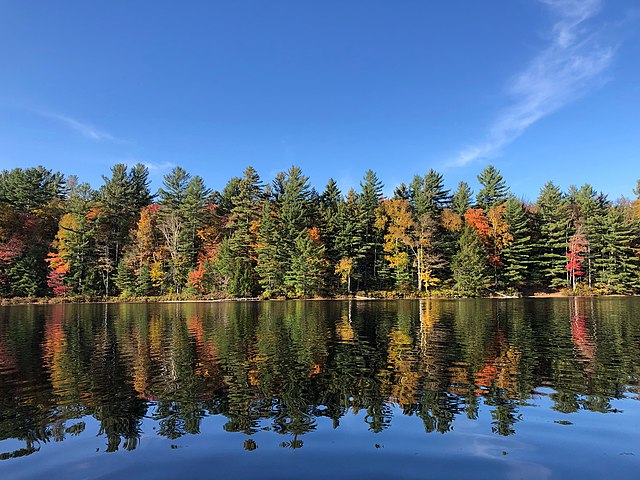Some of the best things I experienced in 2021
Date written: 2022.01.27
I did a lot of new things last year and experienced a huge number of masterpieces. Yesterday was Australia day (a public holiday), so I used the time to write the best of them down in one place.
15. Playing the Pthumerian Descendant Boss from Bloodborne in 60 FPS
When I got a PS4 Pro, I hoped that a lot of PS4 developers who had made games locked to 30 FPS would use the extra processing power to release a 60 FPS patch. This was not the case for Bloodborne. Luckily, in February the Australian hacker Lance McDonald released a patch which did what Sony could not. Applying their patch was easier said than done though.
First, I had to hack a PS4, which was time consuming. (It involved searching Ebay for unopened PS4 Pros with very specific model numbers, updating the software version (offline!) to an exploitable version, connecting to the exploit server and caching an exploit.) Once I had a jailbroken PS4, I then had to apply McDonalds' patch to my copy of Bloodborne, which was also time consuming. (Roughly: dumping Bloodborne to an external hard drive, unpackaging the game file, applying McDonald's patch to a certain file in the unpackaged game, repackaging it and putting it back on the PS4.)
When I launched the modded game for the first time and saw McDonalds' message in the bottom right corner of the screen, a sense of relief washed over me, and I had the biggest smile on my face. Bloodborne is an action game, and I consider action games at 30FPS to be unplayable, so I was happy to finally experience a version of the game that was actually playable. In contrast to the 30FPS version, in 60FPS you can actually see the enemy animations so bosses like Father Gascoigne were more enjoyable. This was especially the case for my favourite boss, the Pthumerian Descendant, which was smooth as silk.
I love everything about that boss — its attacks, how fleeting it is, how deadly it is. Like the best bosses in Bloodborne, it changes midway through the fight, and I had the biggest smile on my face the first time I saw it change. Critics might just say it's basically a Sekiro boss, but that only further the point: it was five years ahead of its time.
14. Watching Reggie's Tap Dancing Scene in Dear White People S4 Chapter V
I've been a fan of Simien's work for a while at this point, and S4 of Dear White People was no different. Whether it was challenging people's assumptions regarding sex work through Michael, playing with our expectations of Zoom calls to create styles of jokes I haven't seen done elsewhere, or presenting opinions which are not widely held (to paraphrase Iesha, "Beyoncé cakewalks better than most"), the show continues to put in work that other shows ignore.
I think one of the best moments from S4 is a scene in which Reggie (Marque Richardson) and his new friend Iesha (Joi Liaye) go to a shooting range. After they discuss feelings of anger and the scrutiny of the white gaze they receive, the two soon begin to sing. And then after a lull in the song Reggie begins to tap dance in front of the targets. As soon as he started doing this I was hit with a pang of emotion which almost made me instantly cry.
There was something about Simien's metaphor which I found profoundly poignant, particularly considering what had happened to Reggie in an earlier season (in an episode directed by Barry Jenkins). When I think about the tap dancing scene, the final remark of Craig Jenkins' To Pimp a Butterfly review comes to mind. "Underneath the tragedy and adversity, To Pimp a Butterfly is a celebration of the audacity to wake up each morning to try to be better, knowing it could all end in a second, for no reason at all."
13. Doing Project 3 in CS 3410
Before I started CS 3410, I came to a realization: it is impossible to be a good programmer without being able to write fast code, and it is impossible to write fast code without understanding computer hardware. I think a lot of people would consider the task of designing and building a CPU to be too difficult and beyond their capabilities (even if doing so on paper), but CS 3410 shatters this opinion. Before I took the class I considered what happened below assembly code to be too mysterious and complicated.
After I had built an ALU in logisim out of basic logic gates (Project 1), I finally understood how a computer actually adds numbers together on the hardware level. And after building a CPU in logisim which translated the 0s and 1s in RISC-V machine code like 0x00308113 into hardware which actually carried out the instructions (in this case addi x2, x1, 3), I realized the basics of CPU design is not too hard, and certainly not beyond most people's capabilities.
Now when I program with systems-level languages, I know how the code I write translates into electrons moving about circuitry, which is not only liberating, but essential to being able to write fast code. As a by-product, knowing how computer hardware works means you can (at some level) start to write software exploits. As I discovered in Project 3, this is very fun indeed.
12. Caving in Upstate NY
You probably already have a good sense of whether you like crawling on all fours for minutes on end in a place so deep underground if you turn your headlamp off you cannot hear or see anything. Caving isn't for everyone, but it is for me, and I very much enjoyed caving in upstate NY. (I wish it had been a bit warmer though.)
Highlights included: a cavern comprised of so much clay that cavers had adorned its walls with hundreds of sculptures they had carved out of the very same walls — and then adding my own to the mix; maneuvering through a passage so convoluted that I was contorting my body in ways I hadn't done since childhood; emerging from a cave and appreciating the ambient noise and warmth of the forest after hours of near silence in the cool.
11. Learning Odin
Once you know a proper programming language (example: C, non-example: javascript), learning other programming languages is a straightforward process. As I discovered when learning Odin last month, even if the language you're learning has only been around for a couple of years and does not have much documentation, learning the basics is not too hard. Especially if you are particularly susceptible to memes.
10. Discovering Black Dresses

How I adore Black Dresses. I first heard of them in 2020, but 2021 was the year I listened to them. Now I cannot imagine my life without them. Forever in Your Heart is easily one of my favourite albums of 2021, and Peaceful as Hell (pictured) is now one of my favourite albums of 2020 too.
Yes, a majority of Black Dresses' music is sad, but it's also relentlessly inventive, beautiful, and with plenty of jokes too. (Black Dresses including a few bars of the corniest tropical synth towards the end of the phrase "And it won't make me feel better to put it in a stupid song" from (Can't) Keep it Together made be laugh out loud and was one of my favourite moments across all songs last year.)
9. Reading Erdos' Result on powers in Pascal's triangle
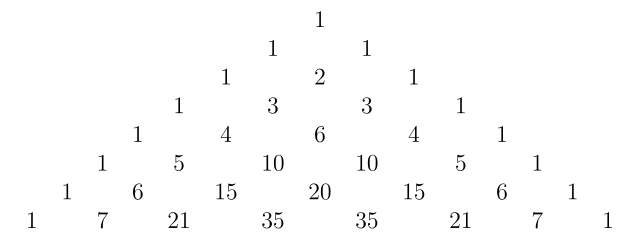
Image credit: Rohieb (public domain)
In mathematics, someone's Erdos number is the length of the smallest path between themselves and Paul Erdos in the graph of published mathematicians. Two mathematics share an edge in the graph if and only if they've published a paper together. Erdos was both prolific and extremely collaborative — he published around 1500 papers over his lifetime.
He was also a genius. This is widely known, although it was only after reading one of his proofs did I understand why. His result on powers in Pascal's triangles is very easy to state and understand, but very difficult to prove.
It says that numbers in Pascal's triangle of the form ab, where a and b are integers with b > 1, are found only in the four outermost layers. In other words, in the (infinite) interior of the triangle, no integer powers exist.
I read his proof in Chapter 3 of Proofs from THE BOOK (4th edition), which is a joy to read overall. I thought his proof was genius. Moving from each line to the next required thought, but (usually) not a huge amount. Despite the simplicity of each step though, once I got to the end, all of the steps had combined to prove the statement. Better yet, the proof was almost self-contained; it didn't require much background in other areas of mathematics (which almost all results in mathematics do), which made the proof even nicer.
8. Watching House of Tisci's Pop Tart Ball performance in Legendary S2
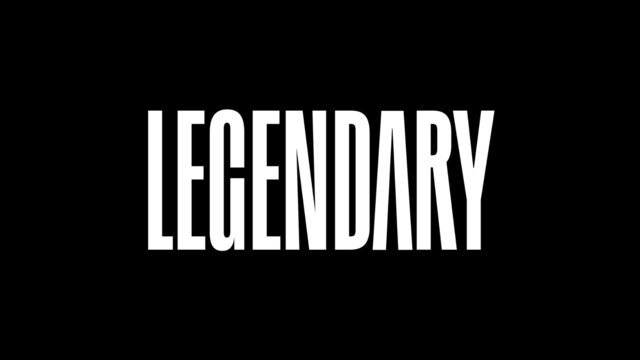
Image source (public domain)
There were many excellent performances in Legendary S2 last year, but the House of Tisci's performance at the Pop Tart ball was something else. A perfect performance in every way, in the words of judge Law Roach, "you did what needed to be done!"
7. Kayaking in upstate NY during the Fall
When someone at my old job learned I'd be doing my PhD at Cornell, they recommended I do some kayaking in Vermont. While they had never kayaked in Vermont themselves, they had heard it was super beautiful. They had kayaked in Canada, so they had some experience.
Upstate New York is not Vermont, but you know, close enough. My colleague was right. Saranac Lake and its surrounding areas in October is one of the most beautiful places I've ever traveled to. It was the best kind of surprise, because I didn't travel with the intention of kayaking! I was up there with my partner as part of a trip comprised largely of MBA students. I booked the kayaks to try something different to hiking on our last day, and I'm so glad I did. The beauty I experienced kayaking on Floodwood Pond (pictured) was astounding.
6. Watching Genius Loci (Andrien Mérigeau, 2020)
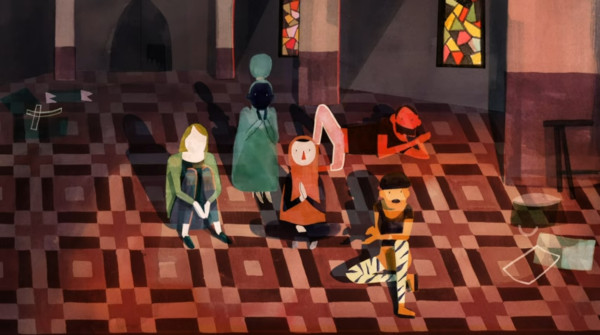
Image: from film trailer
Call me late to the party, but it was only in 2020 that I realized the best films to get Oscar nominations are found not in the Best Director category but the shorts categories (Animated Short, Live Action Short, and Documentary (Short Subject)). This said, last year the nominated entries in the animated section that I saw first included a cute but forgettable film from Pixar and a sad but ultimately apolitical film about gun violence, so I was floored when I watched Genius Loci.
What a phenomenal piece of cinema. It has so many ideas I think it puts the majority of other animated shorts to shame, and it shows how boring a lot of mainstream animation styles have become. Animation is a medium in which every frame can be handcrafted, and as such it is brimming with possibilities. Instead, so many animated films seem occupied with photorealism so end up looking the same. Genius Loci is the first animated film I've seen which actually seems interested in exploring ideas which could only be conveyed by being able to handcraft a consecutive series of frames, and in the process demonstrates how many possibilities the medium has.
I don't know if Mérigeau has both the interest (and funding) to make a feature length animated film that is as dense and innovative as Genius Loci, but I'm really hoping he does. Because I think there are very few people in the world who are able to make a work as expansive, epic, and detailed as "encyclopedic" works like Pynchon's Gravity's Rainbow, but if Genius Loci is anything to go by, Mérigau is one of those people.
5. Playing Level 17 in Heroes of Sokoban II (Jonah Ostroff)
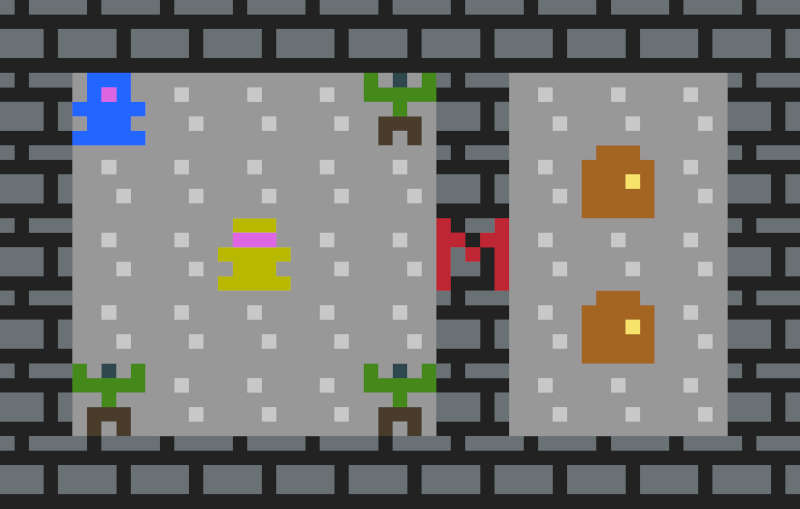
Image: from game source
I think I came across Jonah Ostroff's puzzle games (a fellow mathematician!) while browsing a list of game gems curated by Jonathan Blow. Blow happens to be using the idea of Heroes as the basis for his studio's next original game, and it's not hard to see why. The puzzles in Heroes are by and large excellent, and I think Level 17 (pictured) is the best of them. It is a perfect puzzle, and a masterpiece in every sense of the word.
4. Listening to Apollo 13 (Brady Heywood Podcast, 2018)
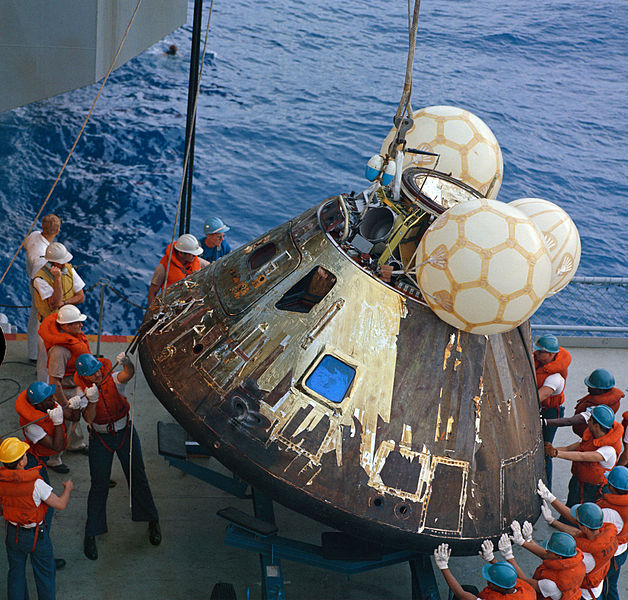
Image credit: NASA (public domain)
Say what you will, but Reddit and Hacker News can have some pretty great recommendations. The tales of engineering disasters which comprise the Brady Heywood Podcast were not something I would have sought out myself, but it was apparent after listening to just one episode that this was very high quality material. After I listened to Part 1 of 5 of the Apollo 13 series, I immediately wanted to listen to Part 2. I was catching a four hour bus ride to NYC the next day however, so I decided to save the rest for the trip.
And I'm glad I did. What a ride. I had no idea how epic the story was. NO IDEA. You probably don't either, or have forgotten. The podcast goes into what some might term excruciating detail, but the detail is essential for understanding the magnitude of the achievement the astronauts and the ground crew pulled off. The podcast is also paced perfectly, with loads of cliffhangers and a couple of moments inducing tears of joy. It's a masterpiece, and easily the best podcast series I've ever heard in my life.
3. Watching Homecoming (Beyoncé, 2019)

Image credit: Kristopher Harris (CC BY 2.0)
One of the things I do with music is to 'save' albums. When I discover an excellent artist, I don't want to listen to their entire catalogue over the span of a few days. I listened to The Dark Side of the Moon years ago but only recently listened to The Wall. I've listened to Revolver tens of times but haven't yet listened to Abbey Road. I like to spread the classics out.
I did the same thing with Beyoncé's Homecoming film. I listened to the soundtrack several times when it came out, but wanted to save watching the film for a later date.
That later date was last year, and nothing could have prepared me for it. When I finished watching Mad Max: Fury Road for the first time, I felt a bit sorry for other people making action films, because Fury Road put them to shame. How can anyone even possibly hope to make something as epic and detailed as that?
I had similar thoughts once the credits rolled in Homecoming. The amount of innovation, creativity, and sheer scale of everything in the performance makes almost all other musical artists seem mediocre. The show is phenomenal fun too. Despite watching it while sitting, I was moving my hands and feet the entire time. I pretty much wanted to dance non-stop but doing so would have meant missing out on the choreography so I had to compromise. It's certainly the best concert film I've ever seen in my life, and I have a strong feeling it will be decades before the world sees a concert film at a similar level, if ever.
2. Watching I May Destroy You (Michaela Coel, 2020)
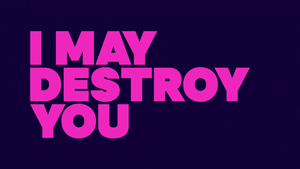
Image source (public domain)
I didn't see this coming, but I should have. I watched S1 of Michaela Coel's previous TV series Chewing Gum earlier in the year, and I had a good time with it. I thought the comedy was pretty fun, and I enjoyed how the series found the humour in its exploration of sex and sexuality while largely being sex positive.
I May Destroy You feels entirely different. Were it not for the fact that Coel stars as the protagonist of both series, I never would have never guessed they had the same author (which was Coel herself). I May Destroy You is incredibly ambitious, and an incredible accomplishment. It's the kind of show I've thought and talked about for hours, but a show for which most people's descriptions, and certainly my own, could never do justice. (Although Angelica Bastién's review and her thoughts on the ending are an exception.) Coel has created one of the best TV series ever made, and the best I've seen in my life so far. I will be returning to I May Destroy You for many decades to come, and I cannot wait to see what Coel creates next.
1. Exploring the American Museum of Natural History, NYC
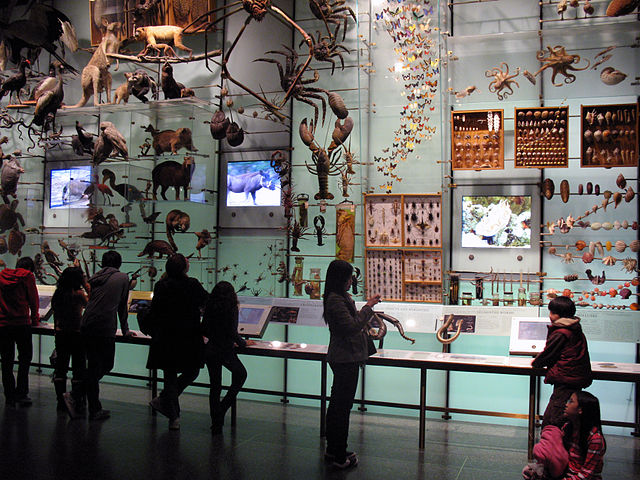
Image credit: Anagoria (CC BY 3.0, GNU FDL 1.2)
This one's a bit unfair, because no matter what pieces of art you hold up to nature, nature has infinite beauty and unfathomable depth, so will always win.
There is a sense of scale and fragility about the world that the majority of us will never understand. (At least those of us who are not astronauts.) I think it's very rare that we come across situations in our daily lives which make us aware of this scale and fragility, but if you're looking for it, the American Museum of Natural History provides this repeatedly.
The 4th floor of the AMNH contains a large collection of dinosaur bones. Seeing illustrations of dinosaurs is one thing, but walking around and seeing a huge number of skeletons of things which used to live and breathe on the same Earth that you and I are living and breathing on too, but more that 50 million years ago, conveys a scale of the history of life on the Earth. The sheer number of species which look unlike anything alive today conveys another scale: how little we know about past life on our planet. But despite these scales, life is extremely fragile, which the museum illustrates in a masterstroke with a particular sample of rock on the wall.
The rock in question contains a couple of different layers. The layers closer to the ceiling are more grey and look flakey, while the rock closer to floor is a darker brown and looks like soil. And sandwiched between two black layers in the middle is a grey layer formed during the Cretaceous-Paleogene extinction event which killed the dinosaurs. I remember looking at the grey layer, thinking "below, dinosaurs, above, no dinosaurs", and thinking about all the different species I had just walked past. The same universe which out of randomness had created the towering complex lifeforms I had just spent hours examining and learning about, was also capable of immediately killing all those species with a single asteroid collision.
The AMNH is capable of generating epic insights that in the moment of understanding make you feel like you are glimpsing something bigger. This is in sharp contrast to the usual situation of reading about something and fooling yourself into thinking you've understood it. I've been to loads of museums before, but the others never quite generated the insights about the world that the AMNH did. I cannot wait to visit it again.
